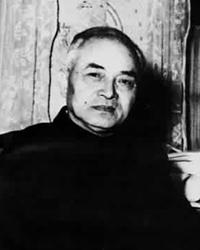Li Siguang (1889~1971), is the founder of China's geomechanics. A native of Huanggang, Hubei, Li studied in Japan and the United States in his early years.
李四光(1889~1971),中国地质力学的创建人,湖北黄冈人。早年曾在日本、美国留学。
He became a geological professor at Peking University upon his return from abroad in 1920.
1920年回国到北京大学任地质学教授。
After the People's Republic of China was established, Li held the positions of deputy president of the Chinese Academy of Sciences and minister of geology.
中华人民共和国成立后,李四光任中国科学院副院长、地质部部长。
In the 1920s, Li Siguang set up the subject of geological mechanics and made great contribution to the geological theory.
1920年,李四光创立了地质力学,为地质理论作出了巨大贡献。

He studied lithosphere with the mechanic theory, and established the tectonic system, one of the basic concepts of tectonic mechanics. He provided new ways to explore the natural phenomena and ushered in new ways of studying the lithosphere movement.
李四光运用力学观点来研究地壳运动现象,建立了“构造体系”这一地质力学的基本概念,为探索地质自然现象提供了新方法,为研究地壳运动规律开辟了新途径。
His theory made great contribution to China's oil reconnaissance and survey, changing the situation of “oil-deficiency" in the country, enabling the large-scale development of oil fields to raise the country to the ranks of the world major oil producers.
他的理论为中国石油勘探作出巨大贡献,改变中国的“缺油”局面,使得大规模的油田发展将中国变成了世界主要的石油生产国。
With the geological mechanics, he analyzed the geology and pointed out that China had abundant oil and gas resources.
李四光运用地质力学分析了中国地质构造特点,认为中国具有广阔的找油远景。
The continuous development of Daqing oilfield, Shengli oilfield and Dagang oilfield proved that Li Siguang was really far-sighted in science.
大庆、胜利、大港等油田的相继发现证实了李四光的科学预见。
In the earthquake studies, Li Siguang emphasized the importance of observing changes in terrestrial stress on the base of studying geological structural movement, and showed clearly the orientation for earthquake forecasting work.
在地震地质工作方面,李四光强调在研究地质构造活动性的基础上,观察地应力的变化,为实现地震预报指出了方向。
What's more, as early as the 1920s, Li Siguang visited many places such as the piedmont of Taihang Mountain, Datong Basin, Lushan Mountain and Huangshan Mountain, and found the vestige variations of the Quaternary Period glacier.
此外,李四光早在20年代初,实地考察了太行山麓、大同盆地、庐山和黄山等地,先后发现第四纪冰川遗迹。
He proved wrong many academic authorities' conclusion that China had no Quaternary Period glacier.
推翻了国际上许多冰川学权威断言中国无第四纪冰川的错误结论。












